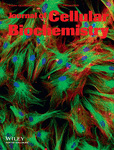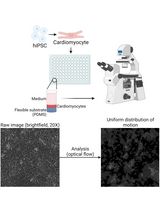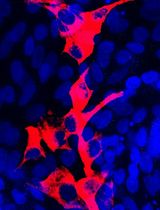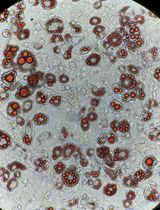- EN - English
- CN - 中文
Mesenchymal Stromal Cells Derived from Bone Marrow and Adipose Tissue: Isolation, Culture, Characterization and Differentiation
骨髓和脂肪间充质干细胞:分离、培养、鉴定和分化
发布: 2020年02月20日第10卷第4期 DOI: 10.21769/BioProtoc.3534 浏览次数: 8730
评审: Ralph Thomas BoettcherShweta SharmaAnonymous reviewer(s)
Abstract
Since their discovery, mesenchymal stromal cells (MSCs) have received a lot of attention, mainly due to their self-renewal potential and multilineage differentiation capacity. For these reasons, MSCs are a useful tool in cell biology and regenerative medicine. In this article, we describe protocols to isolate MSCs from bone marrow (BM-MSCs) and adipose tissues (AT-MSCs), and methods to culture, characterize, and differentiate MSCs into osteoblasts, adipocytes, and chondrocytes. After the harvesting of cells from bone marrow by flushing the femoral diaphysis and enzymatic digestion of abdominal and inguinal adipose tissues, MSCs are selected by their adherence to the plastic tissue culture dish. Within 7 days, MSCs reach 70% confluence and are ready to be used in subsequent experiments. The protocols described here are easy to perform, cost-efficient, require minimal time, and yield a cell population rich in MSCs.
Keywords: Adipose tissue (脂肪组织)Background
The concept of stem cells dates back to the 19th century, but their existence was confirmed in the 1960s and 1970s following experiments by Friedenstein and collaborators, which showed the presence of stem cells in the bone marrow (Friedenstein, 1970; Bianco et al., 2008). Afterward, Caplan (1991) named them as mesenchymal stem cells (here, called mesenchymal stromal cells–MSCs) and proposed their use in regenerative medicine. In the bone marrow, the percentage of MSCc is estimated to be 0.001 to 0.01% of the total mononuclear cells. Because of their scarcity, alternative sources have been described, although bone marrow remains as the main source of MSCs (Nancarrow-Lei et al., 2017). Adipose tissue is a very promising source because it contains a large number of MSCs that are relatively easy to harvest with minimal discomfort and risk for donors (Zuk et al., 2001). The protocols used to harvest and culture MSCs from either bone marrow (BM-MSCs) or adipose tissue (AT-MSCs), may vary among different species or even among different strains of the same species. The most commonly used methods for obtaining MCSs involve using flow cytometry (Schrepfer et al., 2007), multipotent adult progenitor cell media (Harting et al., 2008), the ficoll-paque gradient centrifugation method (Pierini et al., 2012), and immunomagnetic beads (Wadajkar et al., 2014). Here, we describe cost-efficient protocols that are relatively easy and fast to perform and can be used to obtain cell populations rich in MSCs from bone marrow and adipose tissues. These protocols can be used to study several cellular and molecular aspects of MSCs, such as their proliferation, differentiation, and signaling pathways (Abuna et al., 2016; Fideles et al., 2019), the biological effects of growth factors and drugs on MSCs (Oliveira et al., 2012; Zhang et al., 2017), the interactions between MSCs and natural or synthetic biomaterials (Hu et al., 2018; Lopes et al., 2019), and the application of MSCs in regenerative medicine strategies (Almeida et al., 2019; Freitas et al., 2019).
Materials and Reagents
- Sterile surgical drape
- Aluminum foil
- Coat (ProtDesc, catalog number: 80404440020), storage temperature: RT
- Mask (ProtDesc, catalog number: 80404440006), storage temperature: RT
- Cap (ProtDesc, catalog number: 80404440004), storage temperature: RT
- Gloves (Maxitec, Kevenol, catalog number: 80748910002), storage temperature: RT
- 20-ml syringe (BD Plastipak, catalog number: 990687), storage temperature: RT
- 21G needle (BD PrecisionGlide, catalog number: 300054), storage temperature: RT
- Glass tissue culture dish (Pyrex, catalog number: HX0004-00376), storage temperature: RT
- Corning® 75 cm2, U-Shaped canted neck cell culture flask with vent cap (Corning, catalog number: 430641U), storage temperature: 15/30 °C
- 24-well cell culture plates (Corning, catalog number: 3524), storage temperature: 15/30 °C
- 12-well plates (Corning, catalog number: 3512), storage temperature: 15/30 °C
- 6-well culture plates (Corning, catalog number: 3335), storage temperature: 15/30 °C
- 50-ml conical tube (Sarstedt, catalog number: 62.547.254), storage temperature: 15/30 °C
- Microtube 1.5-ml (Eppendorf, catalog number: Z606340), storage temperature: RT
- Micropipette tips (Eppendorf, catalog numbers: 0030000811/0030000854/0030000870/0030000919), storage temperature: RT
- Ultra-low attachment, 96-well (Costar, catalog number: CLS7007), storage temperature: 15/30 °C
- Alpha minimum essential medium (α-MEM) (Thermo Fisher Scientific, catalog number: 12000-022), storage temperature: 2/8 °C
- Dulbecco’s modified Eagle’s medium (D-MEM) (Thermo Fisher Scientific, catalog number: 12100-046), storage temperature: 2/8 °C
- Dulbecco’s phosphate-buffered saline (PBS) (Thermo Fisher Scientific, catalog number: 21600-010), storage temperature: 15/30 °C
- Sodium bicarbonate (Sigma-Aldrich, Sigma, catalog number: S5761-1KG), storage temperature: 15/30 °C
- Gentamycin reagent solution (Thermo Fisher Scientific, catalog number: 15710-064), storage temperature: -20/-5 °C
- Penicillin-Streptomycin (Thermo Fisher Scientific, catalog number: 15140-122), storage temperature: 15/30 °C
- Dexamethasone (Sigma-Aldrich, catalog number: D8893), storage temperature: 2/8 °C
- FBS qualified fetal calf serum (Thermo Fisher Scientific, catalog number: 12657-029), storage temperature: -10 °C
- Amphotericin B 250 μg/ml (Thermo Fisher Scientific, catalog number: 15290-018, storage temperature: -20/-5 °C)
- 0.25% Trypsin (1x) (Thermo Fisher Scientific, catalog number: 15050-057), storage temperature: -20/-5 °C
- Collagenase type II lyophilized (Thermo Fisher Scientific, catalog number: 17101-015), storage temperature: 2/8 °C
- 2.5% Chlorhexidine (Bioflora Manipullarium), storage temperature: RT
- β-Glycerophosphate disodium salt pentahydrate 98.0% (NT) (Sigma-Aldrich, catalog number: 50020-100G), storage temperature: 2/8 °C
- L-Ascorbic acid (Sigma-Aldrich, catalog number: 33034-100G), storage temperature: 15/30 °C
- Ethanol 96% (Merck, catalog number: 100971), storage temperature: 5/30 °C
- Formaldehyde solution 37% (Merck, catalog number: 104002), storage temperature: 15/25 °C
- Isopropanol (Merck Millipore, catalog number:1096341000), storage temperature: 5/30 °C
- Alizarin red S (Sigma-Aldrich, catalog number: A5533-25G), storage temperature: 15/30 °C
- Acetic acid (Merck, catalog number: 199061), storage temperature: 15/25 °C
- 3-Isobutyl-1-methylxanthine (Sigma-Aldrich, catalog number: I7018-1000MG), storage temperature: -20 °C
- Methanol (Merck, catalog number: 1.06009), storage temperature: 5/30 °C
- Insulin human (Sigma-Aldrich, catalog number: I2643-50MG), storage temperature: -20 °C
- Hydrochloric acid fuming 37% (Merck, catalog number: 1.00317), storage temperature: 5/30 °C
- Indomethacin (Sigma-Aldrich, catalog number: I7378-5G, storage temperature: 15/30 °C)
- Oil red O (Sigma-Aldrich, catalog number: O0625-25G, storage temperature: 15/30 °C)
- Trichome stain (Masson) Kit (Sigma-Aldrich, catalog number: HT15-1KT, storage temperature: RT)
- Sodium pyruvate (Sigma-Aldrich, catalog number: S8636, storage temperature: 2/8 °C)
- Human albumin (Institute Grifols, catalog number: A4AFC03441, storage temperature: 2/25 °C)
- Transforming growth factor-β3 (Peprotech Inc., catalog number: 100-36E, storage temperature: -20 °C)
- 4% Paraformaldehyde (Electron Microscopy Sciences, catalog number: 157-4-100), storage temperature: 2/8 °C
- Xylene (LabSynth, catalog number: X1001.01.BJ), storage temperature: 16/26 °C
- Paraffin (EasyPath, catalog number: EP-21-20068A), storage temperature: 15/30 °C
- Eosin (Sigma-Aldrich, catalog number: HT110132), storage temperature: RT
- Monoclonal anti-rat antibody: anti-CD29 (BD Biosciences, catalog number: 562154, storage temperature: 4 °C)
- Monoclonal anti-rat antibody: anti-CD31 (BD Biosciences, catalog number: 555027, storage temperature: 4 °C)
- Monoclonal anti-rat antibody: anti-CD34 (Invitrogen, catalog number: 11-0341-81, storage temperature: 4 °C)
- Monoclonal anti-rat antibody: anti-CD45 (BD Biosciences, catalog number: 554878, storage temperature: 4 °C)
- Monoclonal anti-rat antibody: anti-CD90 (BD Biosciences, catalog number: 554898, storage temperature: 4 °C)
- Monoclonal anti-rat antibody: anti-CD106 (BD Biosciences, catalog number: 559229, storage temperature: 4 °C)
- Transport medium (see Recipes)
- Collagenase solution (see Recipes)
- Trypsin solution (see Recipes)
- Ascorbic acid and β-Glycerophosphate solution (see Recipes)
- Growth medium (10% MEM) (see Recipes)
- Osteogenic differentiation medium (see Recipes)
- Chondrogenic differentiation medium (see Recipes)
- Adipocyte differentiation medium (see Recipes)
- Dexamethasone stock solution (200 μM) (see Recipes)
- Ascorbic acid stock solution (20 mM) (see Recipes)
- TGF-β3 (see Recipes)
- Oil red O staining (see Recipes)
Equipment
- Scissors (Quinelato, catalog number: QT.109.14)
- Forceps (Quinelato, catalog number: QC.301.14)
- Erv-Mount® (EasyPath, catalog number: EP-51-05041), storage temperature: 20 °C
- Micropipette (Eppendorf, catalog numbers: 4921000028/4921000044/4921000079/4921000109/4921000117/4921000150)
- Analytical balance M214A (BEL, catalog number: BL0003)
- RT basic series magnetic stirrers (Thermo Fisher Scientific, catalog number: 88880009)
- Bench meter for pH (Hanna, catalog number: HI5522-01)
- Stericup quick release vacuum driven disposable filtration system (Merck, catalog number: S2GPU05RE)
- Vacuum pump and compressor (Prismatec, catalog number: 132)
- Airstream class II biohazard safety cabinet (Esco Micro Pte.Ltd., model: AC2-4E8)
- Microprocessor water bath (Quimis, catalog number: Q215M)
- CO2 incubator (Panasonic, Panasonic/Sanyo, model: MCO-19AIC)
- Eppendorf® Centrifuge 5702 (Sigma-Aldrich, catalog number: Z606936)
- Axiovert 25 inverted microscope for advanced routine (Carl Zeiss)
- Compact digital microplate shaker (Thermo Fisher Scientific, catalog number: 88880023)
- Epoch 2 microplate spectrophotometer (BioTek, catalog number: BTEPOCH2)
- Centrifuge 5418 R (Eppendorf, catalog number: 5401000013)
- Gas exhaust chapel (Lutech, catalog number: LCE-15)
- Vertical freezer, 231 liters (Consul, catalog number: CVU26EB)
- Refrigerator frost free, 342 liters (Consul, catalog number: CRB39AB)
- Ultra-low freezer (Panasonic, catalog number: MDF-U500VXC-PA)
- FACSCantoTM II (BD Biosciences, catalog number: 338962)
- Paraffin dispenser (Oma, catalog number: IO-88)
- Microtome (Micron, GMI, catalog number: 8243-30-0001)
Software
- Gen 5 TS 2.06 (BioTek Instruments Inc./BioTek, https://www.biotek.com/products/software-robotics-software/gen5-microplate-reader-and-imager-software/)
- BD FACSDivaTM Software v8.0.3 (https://www.bdbiosciences.com/en-us/instruments/research-instruments/research-software/flow-cytometry-acquisition/facsdiva-software)
- StepOne Software v2.3 (Thermo Fisher Scientific/Applied Biosystems, https://www.thermofisher.com/br/en/home/technical-resources/software-downloads/StepOne-and-StepOnePlus-Real-Time-PCR-System.html)
Procedure
文章信息
版权信息
© 2020 The Authors; exclusive licensee Bio-protocol LLC.
如何引用
Freitas, G. P., Souza, A. T. P., Lopes, H. B., Trevisan, R. L. B., Oliveira, F. S., Fernandes, R. R., Ferreira, F. U., Ros, F. A., Beloti, M. M. and Rosa, A. L. (2020). Mesenchymal Stromal Cells Derived from Bone Marrow and Adipose Tissue: Isolation, Culture, Characterization and Differentiation. Bio-protocol 10(4): e3534. DOI: 10.21769/BioProtoc.3534.
分类
干细胞 > 成体干细胞 > 脂肪干细胞
干细胞 > 成体干细胞 > 造血干细胞
细胞生物学 > 细胞分离和培养 > 细胞分化
您对这篇实验方法有问题吗?
在此处发布您的问题,我们将邀请本文作者来回答。同时,我们会将您的问题发布到Bio-protocol Exchange,以便寻求社区成员的帮助。
Share
Bluesky
X
Copy link















